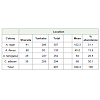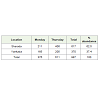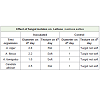Research Article
Isolation and Identification of Pathogenic Fungi Causing Deterioration of Lettuce Plant (Lactuca sativa) A Case Study of Yankaba and Sharada Vegetables Markets
Yahaya SM*, Fagwalawa LD, Ali MU, Lawan M, Mahmud S
Department of Biology, Kano University of Science and Technology, Wudil P.M.B. 3244
Corresponding author: Yahaya SM, Department of Biology, Kano University of Sciences and Technology, Wudil -KanoState P.M.B. 3244, Nigeria; E-mail: sanimyahya@gmail.com
Citation: Yahaya SM, Fagwalawa LD, Ali MU, Abdullahi H, Umma M, et al. Symptomless Transmission of Seed Borne Botrytis Cinereainto the Seed Of Next Generation Lettuce Plant (Lactuca Sativa). J Plant Sci Res. 2016;3(1): 140.
Copyright © 2016 Yahaya SM, et al. This is an open access article distributed under the Creative Commons Attribution License, which permits unrestricted use, distribution, and reproduction in any medium, provided the original work is properly cited.
Journal of Plant Science & Research | ISSN: 2349-2805 | Volume: 3, Issue: 1
Submission: 11/12/2015; Accepted: 04/01/2016; Published: 16/01/2016
Abstract
Experiment was carried out to determine the fungal pathogens responsible for post-harvest losses of Lettuce on sale at Yankaba, and Sharada, market for a period of three months (September, 2014 to December, 2014). Sample of lettuce was collected and analyzed for the presence of fungal species using standard methods. Fungal deterioration in the two markets were mostly due to Candida albican, occur with 30.1%, Aspergillus niger with the rate of 31.1%, while Aspergillus fumigatus and Aspergillus flavus had occurrence rates of 25.5% and 13.8% respectively. The differences in fungal deterioration of the lettuce was found to be statistically significant (P>0.05) between the two sampling dates. The results of this study found that a post-harvest loss of the lettucein the two vegetable markets was due to attack by fungal species.
Keywords: Post-harvest, Mould, Irrigated areas, Incidence
Introduction
Lettuce, lactuca sativa, is a member of the family Asteraceae (Compositae) [1]. Lettuce is annual herbaceous plant with broad leaves of variable sizes and form arranged in a rosette. It has a single main root with broad fibrous lateral branches. The stem is cylindrical and contains latex. Lettuce is one of the UK vegetable crops [2,3]. It is important in most temperate climate production systems and in other regions like West Africa where it is the most popular salad crop [2,4]. In addition to its main use as a leafy green, it has also gathered religious and medicinal significance over centuries ofhuman consumption.
Lettuce cultivars can be grouped into four of five types, basedon the plant form and use. The crisphead (or iceberg) forms form a closed heads which is resistant to mechanical damage. These arethe most important type grown and form the bulk of productionin Europe and America [5]. The butter head type forms loose openheads and soft leaves easily damage in handling. Leaf lettuce alsoshares this fragile nature. Cos or romaine lettuce has erect, elongatedleaves that forms a loose leaf-shaped head. Stem lettuce is grown forits thickened parenchymatous stem harvested when the plant is stillin the vegetative stage [6,7].
Lettuce has very high water content, 94-95% in the various formsbut with some variation in the nutritional content. Crisphead lettucesupplies amounts of ascorbic acid (7 mg/100g), vitamin A (470 I. U./100g) and calcium (22 mg/100g). On the other hand butterheadlettuce contributes 8 mg of ascorbic acid, 1065 I. U. of vitamin Aand 35 mg of calcium per 100 g of edible product. Cos lettuces are more nutritious. They supply 22 mg of ascorbic acid, 1925 I. U. ofvitamin A and 44 mg of calcium in 100 g of edible product [8,1]. Leaflettuce supplies 18 mg ascorbic acid, 1900 I. U. of vitamins A, 68 mgof calcium in 100 g of edible product. Lettuce, regardless of type, alsosupplies some phosphorus, iron, sodium and potassium [9,1].
Diseases causes a serious problem for lettuce growers andmarketers; and for many diseases there are no opportunities for theircontrol once the crop has been infected. Lettuce diseases may resultfrom attack by viruses, fungi, bacteria, nematodes or from a nonpathogenicsource. Some diseases are seed-borne [10], others are airborne[5], while others are transmitted by insects or microorganisms[5].
Large quantities of vegetables are produced in Nigeria. However,accurate production figures are not available. In previous studies[11] reported that production of vegetables is seasonal resulting inabundant supply during the rainy season and scarcity at dry seasons.Due to their soft texture they are easily wounded as a result ofharvesting, and other post harvest handling operations such aspackaging, transportation and storage [12,13] reported that the longchain of marketing system of vegetables between the producer andconsumer makes it difficult to accurately assess the level of damagein many crops in Nigeria. In [14] FAO report indicated that Nigerianvegetables have not been able to meet world standard because ofpoor harvest handling. The present study was aimed at identifyingfungal species associated with post-harvest losses in Lettuce witha view to providing baseline information for the development ofcontrol strategies for reducing post-harvest losses which will increaseavailability and reduce cost of the produce.
Material and Methods
Sampling Site
Sharada: is located at Gwale local government area of Kano statea distance of about 50 Klm away from Kano University of Science andTechnology, Wudil. It is one of the large vegetable markets in Kanostate. There are no fruits and vegetables grown in Kano state thatare not found at Sharada. Despite being one of the largest vegetablegrowing and selling markets at Kano metropolitan, there are no goodstorage facilities at Sharada market. Some marketers store their fruitsand vegetables on the floor of the stores, while others kept theirspacked in baskets. Marketers hardly used chemicals on their fruitsand vegetables. They however washed them either with water ordetergents.
Yankaba: is located at Nassarawa Local Government area with adistance of about 50klm away from Kano University of Science andTechnology, Wudil. It is one of the large vegetable markets in Kanostate. There are no fruits and vegetables grown in Kano state thatare not found at Yankaba. Despite being one of the largest vegetablegrowing and selling markets at Kano metropolitan, there are no goodstorage facilities at Yankaba market. Some marketers store their fruitsand vegetables on the floor of the stores, while others kept theirspacked in baskets. Marketers hardly used chemicals on their fruitsand vegetables. They however washed them either with water ordetergents.
Sample Collection
Lettuce was collected from Sharada and Yankaba markets KanoState. Samples were collected two times in a week, Mondays andThursdays respectively which lasted for three months. The sampleswere collected directly from the market inside polyethene bag(container) to the laboratory in (K U S T Wudil) for analysis.
Isolation Media
Potato dextrose agar was the media used for isolation of postharvestfungi in lettuce sample. Thirty nine grams of PDA wereweighed using weight balance and suspended in 1litre of distilledcool water. The contents were sterilized by autoclaving machine at1210c for 15 minutes. These were allowed to cool for 5 minutes ona laboratory bench until the temperature fell to 450oc.ten millilitersof lactic acid were added to inhibit bacterial growth. The media wasdispensed into sterilized Petri dishes of 9cm diameter.
Procedure for Isolation of Fungi
The isolation was carried out according to the method describedby [14-16] as follows 39g of powdered PDA was weighed usingweighing balance and dispense in one liter of distilled water, stirredthoroughly before been place inside the flask bottles and autoclavedinside the machine. The media was later poured into sterilized petridishes and allowed to solidify. The sample obtained from Kwakwachiirrigation area was sterilized by washing in running tap water andallowed to dry. Portions (2mm) were cut with a sterilized cork borer.Cut pieces were placed on PDA and incubated at 25.7 ±2 c for 3 days.
Colony Count and Subculture
Fungal colonies that grown were observed accounted andrecorded. Each distinct colony was sub cultured into fresh PDAmedia to facilitate possible identification.
Determination of Pathogenicity of Isolated Micro Organism
Pathogenicity tests were conducted to prove Koch postulate.Healthy leaves of lettuce vegetable surface sterilized in 10% (v/v)sodium hypochlorite solution and rinsed in 3 changes of running tapwater and allowed to dry. A ruler was used to mark a (2mm) diametercircle on each sample and sterilized needle was used to streak fungalhyphae on the marked portions. Controls were inoculated withdistilled water. Both were placed on the laboratory bench. Sterilizedforceps were used to remove portions from the diseased areas on the4th day and placed on freshly prepared PDA plates and incubated at25.7 ±2oc for 3 days. Fungal growth that appeared was recorded.
Microscopic Examination
For each examination, a streak of fungal mycelium was placed ona clean glass slide. One drop of cotton blue lacto phenol was addedand the cover slip placed. The slide was mounted on the microscopeand observed at magnification of ×10, ×40 and ×100. Morphologicalcharacteristics of fungi isolated were determined and identified usingmethod described by [17]. Lengths of the hyphae were determinedwith eyepiece graticule by using colonial and morphologicalcharacteristics.
Photography
Photographs of fungal mycelia were taken from mounted slideusing camera Lucida at Biology Department, Kano University ofScience and Technology, Wudil.
Statistical Analysis
Data collected on fungal colonies was analyzed using s Chisquareanalysis. This was achieved using computer program GrapPAD insert Version 1.15 copyright 1990 [18].
Results
Infection of fungal species was recorded on all the leaf samples. Atotal of 987 colonies were counted and recorded which belong to theC. albican and the three species of Aspergillus. Thus were Candidaalbican 294(%) A. niger {307 (31.1%}), A. flavus {135 (13.8%}), A.fumigatus {252 (25.5%)}. Control plates showed no growth (Table 1).
Variation of the colony counted in Sharada and Yankabamarket
Sharada area recorded the highest colony count with 617 (62.5%).Where a total of 211 (56.1%) and 406 (66.4%) colonies was recordedon Monday and Thursday respectively. The least colony countwas recorded at Yankaba, market area with a total of 370 (37.4%),comprising 165 (43.8%) and 205 (33.5%) on Monday and Thursdayrespectively.
Variation in the colony counted on Monday and Thursday
A total of 376(38.0%) were recorded in the Monday, while 611(61.9%) were recorded during Thursday exposure (Table 2).
Table 2: Variation in the colony count of all the species for the two selected sites on samples collected on Monday and Thursday.
Pathogenecity test
The results of the pathogenicity test confirmed all the four criteriaoutline in Koch postulates for identification of the causative agent ofa particular disease. The pathogen where present in all cases of thedisease. The same pathogens was isolated from the diseased hostand grown in pure culture. When inoculated into a healthy sample of lettuce plant the pathogen from the pure culture causes the samedisease. The same pathogen was reisolated from the new host andshown to be the same as the originally isolated pathogen (Table 3).
Discussion
A total of 387 colonies were isolated during the study. Fungiisolated include A. niger, A. flavus and C.albican (yeast). The generaA. niger was the most frequently occurring with the percentageoccurrence of 31.1% followed by C. albican with percentageoccurrence of 30.1%, A. fumigatus with percentage occurrence of25.5% the least occurring colony was A. flavus with percentageoccurrence of 13.8%. Pathogenicity test confirmed the pathogensas originally isolated pathogen of lettuce sample from Sharada andYankaba markets. More colonies where recorded at Sharada thenYankaba markets. Also high number of colonies was recorded onMonday exposure than Thursday exposure.
Alao [19] reported that many of the post-harvest diseases offruits and vegetable, grains and legumes are the result of infectionsby pathogens in the field which continue to develop after harvest. Ina related study [20] reported that fungi are the most common causeof spoilage on fruits and vegetables and several fungi like penecilliumspp, cladosporium spp, and altternaria phomopsis are known to causelarge scale storage loss of fruits and vegetables from harvest to storage.
The finding of this research support the report of [13] whostudied fungal deterioration of some vegetables in northern Nigeriaand found that losses in spinach is attributed to the activities of A.niger, A. fumigatus , Mucor, and Rhizopus stolonifer. The findingalso agrees with the work of [21,20] who isolated, A. niger, A. flavus,Rhizopus, and Mucor from samples of vegetables grown at Nassarawalocal government area of Kano state.
The higher count obtained on Monday could be due to heavyactivities with high influx of customers from different locations onthe day for buying and selling. Statistical difference of (P >0.05) wasobtained between the two seasons (Table 2).
It can be concluded that the four fungal species namely Candidaalbican, A. niger, A. fumigatus, and A. flavus, are the common postharvest fungi associated with lettuce on sale at the studied markets.The results obtained in this study indicate that Yankaba, site is themost suitable for marketing of fresh and healthy vegetables. Thisis because in Yankaba area there is total absence of household andindustrial effluents in the area surrounding the market this accountedfor the least colony count. Sharada site is the least suited for marketing of vegetables because, effluents from household and industries in the surrounding area were the source of infection. The effluents mightcontain toxic chemicals that on long time exposure could pose serioushealth hazards to the consumers of these vegetables. Therefore, tosafe guard the consumers from buying produce which may be ofhealth hazard effort should be made ensure that all effluents fromhousehold and industries be adequately treated before discharge intothe surrounding environment. Likewise marketing of crops shouldbe prohibited in any area close to household and industrial effluentsdischarge [23].
References
- Mustapha Y, Yahaya SM (2006) Isolation and Identification of Post-harvest fungi of Tomato (L.esculentum) and Pepper (Capsicum annum) Sample from selected Irrigated sites in Kano. Biological and Environmental Science Journal for the Tropics 3: 139-141
- Rajaguru BAP (2008). Molecular ecology of Botrytis cinerea. PhD thesis. University of Reading, Reading, UK.
- Sani MY, Alao SEA (2006) Assessment of post-harvest fungi of Tomato(Lycopersicon esculentum) and Pepper (capsicum annum) from selected irrigated areas of Kano State. Journal of Bioscience 2: 53-56.
- Opadokun JS (1987) Reduction of Post-Harvest Losses in Fruits and Vegetables. Lectures Delivered at AERLS/Nigerian Stored Product Research Institute. Joint National Crop Protection Workshop, IAR, Zaria 3- 26.
- Cho J (2008) Winter diseases of lettuce. Commodity fact sheet, Vegetable. University of Hawaii Institute of Tropical Agriculture and Human Resource.
- Zepp G, Robert D, Hoff F, Lee H, Somwaru A (1994) Lettuce: An economic assessment of the feasibility of providing multiple-peril crop insurance prepared by the economic research service, USDA in cooperation with the University of California.
- Grierson D, Kader AA (1986) The Tomato Crop Fruit Repining and Quality. Chapman and Hall Ltd, New York. 243- 280.
- Sowley ENK (2006) Epidemiology of Botrytis cinerea, PhD Thesis, University of Reading. UK.
- Elias SNK, Shaw MW, Dewey FM (2010) Persistent symptomless, systemic and seed-borne infection of lettuce by Botrytis cinerea. European Journal of Plant Pathology.126: 61-71.
- Norman JC (1992) Tropical Vegetable Crops. 13-53. Stock well Ltd. NewYork.
- Shafia A (2009) Latent infection of Botrytis cinerea. Un published PhD Thesis. University of Reading. UK.
- Magashi AI, Adnan A (2004) Theoretical model for uninterrupted supply of Lycopersicon esculentum (tomato)for economic reliance in northern Nigeria. Paper presented at the 3rd Annual conference of Education for Rehabilitation and reliance.
- Food and Agricultural Organization (1989) Training Manual FAO. Rome. 20-56.
- Amadioha AC (1999) Controlling Rice blast in Vitro and Vivo with extract of Azadirachter indica. Crop production 19: 20-41.
- Eckert JW (1999) Post-harvest diseases of Citrus fruits. Outlook on Agric 9: 225-232.
- Williams CN, Uzo JO, Peregrine WT (1991) Vegetables Production in the Tropics. Longman, England. Pp 70- 82.
- Dorothea F, Ronald J, Ronald CB (1976) A Colour Atlas of Pathogenic Fungi. Wolfe Medical Publication Ltd. Pp 12- 53.
- Crawley MJ (2005) Statistics: An introduction using R. Published in 2005 by John Wiley & Sons, Ltd.
- Alao SEL (2000) The importance of post harvest loss prevention. Paper presented at graduation ceremony of school of food storage technology. Nigerian Stored Products Research Institute, Kano. Pp 1-10.
- Yahaya SM (2005) Contribution of harvest to pathogenic and non pathogenic losses of vegetables. Unpublished Msc. Thesis. Bayero University Kano.
- Kuku FO, Akano DA, Olarewaju TO, Oyeniran JO (1980) Mould Deterioration on Vegetables. NSPRI Technical Report. No. 8, 1985 Annual Report. Pp 89-94.
- O’Neil, T. M., Shtienberg, D. and Elad, Y. (1997b). Effect of some host and microclimate factors on infection of tomato stems by Botrytis cinerea. Plant Disease. 81: 36-40.
- Hayatu, M. (2000). Post Harvest Physiological Studies of Some Selected Members of Family Solanaceae. Unpublished M. Sc thesis. Bayero University, Kano. Pp 2 – 25.



